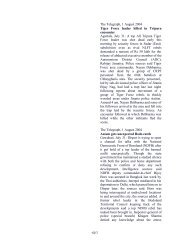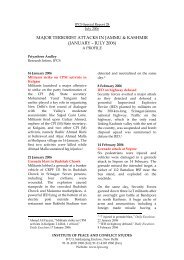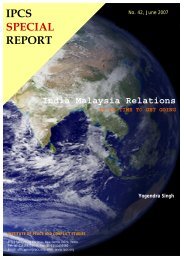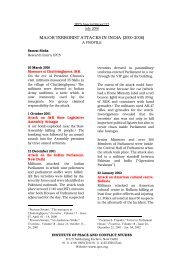April-June 2013 - Institute of Peace and Conflict Studies
April-June 2013 - Institute of Peace and Conflict Studies
April-June 2013 - Institute of Peace and Conflict Studies
You also want an ePaper? Increase the reach of your titles
YUMPU automatically turns print PDFs into web optimized ePapers that Google loves.
Commentary<br />
India, China & the Brahmaputra: Riparian Rivalry<br />
Roomana Hukil<br />
Research Officer, IReS, IPCS<br />
China's proposed strategic interests behind the building <strong>of</strong> the<br />
run-<strong>of</strong>-the-river dams along the middle reaches <strong>of</strong> River<br />
Brahmaputra, provides insignificant data over the nature <strong>of</strong><br />
the project in the future course <strong>of</strong> time. As the Indian<br />
government rests on the Chinese assurance <strong>of</strong> the unalterable<br />
status quo, the Assamese government has raised serious<br />
doubts on the Chinese prospects over the watercourse.<br />
In this regard, it is time for an establishment such as that <strong>of</strong> the<br />
Brahmaputra River Valley Authority (BRVA) to undertake<br />
effective scientific investigation with respect to both the lean<br />
flows <strong>of</strong> the river <strong>and</strong> the consequences <strong>of</strong> the dam<br />
constructions by the Chinese over the river. This article delves<br />
into assessing the potential factors that are leading China into<br />
building the multiple dams. It questions China's proposition<br />
vis-à-vis the mounting threats <strong>and</strong> assesses the establishment<br />
<strong>of</strong> a joint authoritative body to ensure the regulatory flow <strong>of</strong><br />
the waters, in order to provide a timely scientific data <strong>of</strong> the<br />
cause <strong>and</strong> effects <strong>of</strong> the river.<br />
Potential Factors for China's Propag<strong>and</strong>a<br />
The Brahmaputra River in China (known as Yarlung Tsangpo)<br />
has been <strong>of</strong> significant strategic interest for the Chinese since<br />
the 19th century." With an average elevation <strong>of</strong> about 4000<br />
metres, the river provides for the hydroelectricity power<br />
needs <strong>of</strong> the country. In addition, some areas within China<br />
have been experiencing their worst drought in at least 50<br />
years. Therefore, it is believed that by diverting the river<br />
system via constructing the proposed dams, the river will<br />
provide for the growing needs <strong>of</strong> the country; prove to be a<br />
useful mechanism in flood control methods <strong>and</strong> serve the<br />
waterway navigational purposes <strong>of</strong> the country.<br />
China upholds the principle <strong>of</strong> 'Prior Appropriation', meaning<br />
that, as the first users <strong>of</strong> the river course, it must be granted<br />
the right <strong>of</strong> accessing the river without external interferences.<br />
This also marks a geo-strategic advantage for China to enforce<br />
its power structure in the South Asian region. For China, the<br />
building <strong>of</strong> the dams is merely a run-<strong>of</strong>-the-river project that<br />
will not hold the water <strong>of</strong> the lower riparian states. However,<br />
China's growing interests from the 'Tibet Three Gorges Dam',<br />
(one <strong>of</strong> the biggest dams in China) construction on the Pondo<br />
Water Control Project in 2008, which is expected to be<br />
completed in 2016, coupled with the 60 odd number <strong>of</strong> dams<br />
raises serious environmental <strong>and</strong> risk concerns for its<br />
downstream South Asian counterparts. Comprised <strong>of</strong> a<br />
reservoir <strong>and</strong> a power station, the projects are designed to<br />
irrigate millions <strong>of</strong> hectares <strong>of</strong> farml<strong>and</strong> <strong>and</strong> generate millions<br />
<strong>of</strong> kilowatt hours <strong>of</strong> electricity annually.<br />
India's Strategic Move<br />
The recent exchange <strong>of</strong> state visits over the Brahmaputra<br />
discourse by China <strong>and</strong> India on the sidelines <strong>of</strong> the BRICS<br />
Summit questions the efficacy <strong>of</strong> the state <strong>of</strong> affairs,<br />
pertaining to a change in the projected plans. While Prime<br />
Minister Manmohan Singh raised India's concerns over<br />
Beijing's plans to construct three dams across the<br />
Brahmaputra River, President Xi Jinping, as part <strong>of</strong> the decadal<br />
change <strong>of</strong> power structure in China, maintained that the dams<br />
are, merely, run-<strong>of</strong>-the-river projects <strong>and</strong> are innocuous.<br />
Since there is no definitive alignment <strong>of</strong> the nature <strong>of</strong> the<br />
projects merely being run-<strong>of</strong>-the-river, India's subsequent<br />
course <strong>of</strong> action should entail restructuring the Brahmaputra<br />
Board <strong>and</strong> replacing it with the Brahmaputra River Valley<br />
Authority (BRVA). There is an apprehension being expressed<br />
throughout the Asian regime who are dem<strong>and</strong>ing to know the<br />
quantity <strong>of</strong> water that the Chinese are planning to divert.<br />
Therefore, dem<strong>and</strong>ing a bilateral collaborative study between<br />
the two countries will help allay these fears. Since no flood<br />
mitigation measures are in place, there is an excessive<br />
amount <strong>of</strong> water in the river which is not contained in any<br />
reservoir. Further, China holds no water sharing agreement<br />
between any <strong>of</strong> its co-riparian neighbours <strong>and</strong> is continually<br />
propositioning new dam constructions with zero lateral<br />
negotiations over the effects <strong>of</strong> its plans. Considering<br />
relations at stake due to China's disposition, it is essential that<br />
the Brahmaputra River Valley Authority, if established, look<br />
into the present needs <strong>and</strong> evolving dynamics pertaining to<br />
irrigation, food security, climate change, flood preventive<br />
modules, hydroelectricity, ecology, etc. <strong>of</strong> the sub-regional<br />
arena.<br />
Notwithst<strong>and</strong>ing pledges to take the bilateral relationship to a<br />
new level with a higher growth trajectory, Prime Minister<br />
Manmohan Singh has sought a joint mechanism with China to<br />
assess the construction work on dams on the river. This will<br />
ensure a steady assessment <strong>of</strong> the work in progress vis-à-vis<br />
foresightedness in dam construction activities <strong>and</strong> will also<br />
safeguard Sino-Indo relations from getting muddled in the<br />
long run. By establishing a joint mechanism committee, the<br />
Indian government will be able to re-affirm its loose ties with<br />
the Northeast. Assam's vociferous claims to the central<br />
government over the issue have pushed the UPA into taking<br />
immediate action. However, the onus is still on India for<br />
looking at the tripartite aspects <strong>of</strong> the water-sharing<br />
discourse, as regards, its relations with Bangladesh loosely<br />
hanging despite weighty political ambitions being raised over<br />
the Teesta River. Presently, India needs to act swiftly over the<br />
Teesta discourse with Bangladesh whilst pushing for<br />
affirmative action over the Brahmaputra River with China in<br />
order to maintain a steady balance with its riparian<br />
counterparts in the region.<br />
South Asia Plus 33

















